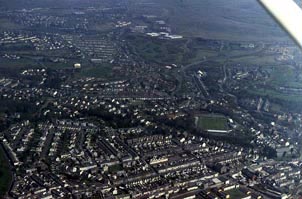Historic Landscape
Characterisation
Merthyr Tydfil
003 Penydarren Park and Gwaelod-y-Garth
HLCA 003 Penydarren Park and Gwaelod-y-Garth Premier middle-class
suburban development over former parkland; regular blocks of terraces
and larger semidetached and detached villas; site of former ironworks
master's residence; prominent recent leisure function
Click here for
a character area map
Summary
This residential area developed from the late 1870s on the former parkland of Penydarren House, an ironmaster's residence. By 1919 it had become the premier middle-class suburban area of Merthyr Tydfil. It contains a series of large semi-detatched villas and a number of public buildings such as the YMCA and the Masonic Temple.
Historical background
The historic landscape area of Penydarren Park and Gwaelod-y-Garth comprises the core area of former parkland and holdings associated with Penydarren House, seat of the Homfray family owners of the nearby Penydarren Ironworks. Built by Samuel Homfray in 1786, the house was 'sufficiently removed from the town by the extent of the pleasure grounds, and contains all the conveniences and the luxuries requisite for a family of wealth and importance'. The house, which later housed the Merthyr Proprietary School (1876-1888), was demolished in 1966; Penydarren Park football grounds now occupy the site
The core of the estate has seen urban development since the late 1870s. By 1905 the former fish pond marked at Bryant's Field, at the south western edge of the area appears to have been infilled and initial urban development of linear ribbon terraces along Gwaelod-y-Garth lane, and terraces of Stuart, Cromwell, and Tudor. Development of the period included a school and general hospital, the Roman Catholic Church of St. Mary's (1893-4, JS Hansom, Early English style) and the imposing Park Terrace and nearby large villas. By 1919, the area had developed into Merthyr Tydfil's premier middle-class suburb with the addition of further terraces in the area east of the walk, north and south of Dane Street and Terrace, with additional properties along the Grove. The holding associated with Gwaelod-y-Garth was further developed during the period. Most of the large imposing structures at the south of the area date to the period and include the currently disused, four-storied Edwardian Baroque YMCA (1909-191 1. lvor Jones & Percy Thomas) and the Classically influenced Masonic Temple (1910, CM. Davies of Merthyr Tydfil).
